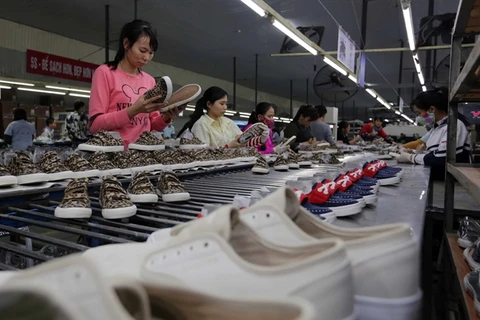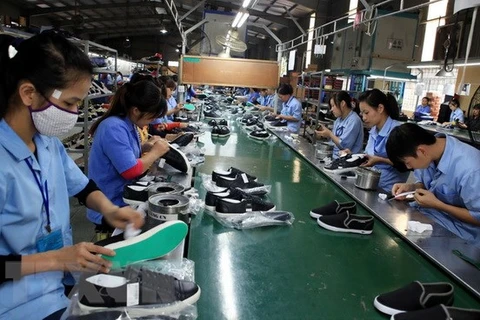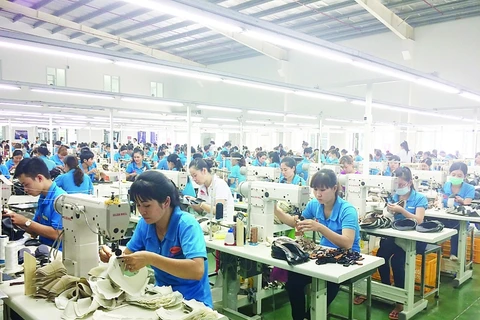 Leathers and footwear firms step up production and optimise opportunities presented by FTAs to boost exports. (Photo: Vietnamplus)
Leathers and footwear firms step up production and optimise opportunities presented by FTAs to boost exports. (Photo: Vietnamplus) Hanoi (VNA) – Vietnam’s leather and footwear export saw rosy signs in the first quarter of this year compared with the same period last year, with footwear export turnover reaching 4.74 billion USD, up 13.5 percent.
It is noteworthy that domestic firms have been able to adapt to the new situation as COVID-19 is spreading.
According to Phan Thi Thanh Xuan, Vice President and Secretary General of the Vietnam Leather-Footwear and Handbag Association (Lefaso), apart from impacts of the pandemic, the sector faced surging material prices and transportation costs, and a lack of containers in the first months of this year.
Both local and FDI businesses in the sector need time to overcome the current pandemic-caused difficulties as well as losses left from the previous year, she said.
Regarding the supply chain disruption caused by the COVID-19, Xuan pointed out that more than 60 percent of materials in the sector is imported from China, and urged domestic enterprises to seek ways to develop materials, thus easing the reliance.
 Phan Thi Thanh Xuan, Vice President and Secretary General of the Vietnam Leather-Footwear and Handbag Association (Lefaso) (Photo: VietnamPlus)
Phan Thi Thanh Xuan, Vice President and Secretary General of the Vietnam Leather-Footwear and Handbag Association (Lefaso) (Photo: VietnamPlus) Many local enterprises have paid attention to brand building. However, to further promote Vietnamese brands, more investments should be funneled into resources and knowledge, Xuan said.
Although some brands such as Bitis and Giovani have successfully established a foothold in the international market, the work requires greater efforts, she added.
Once the pandemic is contained, Vietnam will be an ideal destination for leather and footwear importers, she said, expressing her hope for export growth in the sector.
Vietnamese leather and footwear firms have optimised the EU-Vietnam Free Trade Agreement (EVFTA). Moreover, the free trade agreement between Vietnam and the UK has also opened up substantial opportunities for them.
Therefore, in the next decade, the sector will grow further, she believed.
Economic experts said it is now time for Vietnam to look directly at the shortcomings of the domestic footwear industry. First of all, most enterprises operate in the cut, make, and trim (CMT) mode. Because they export through foreign intermediaries, they have not yet built their own brands. Enterprises have also failed to grasp information about the trends of markets and customers, that is why they remain passive in production. Most enterprises only produce upon the orders placed by partners.
As for the value chain, domestic enterprises are losing the balance between stages. Particularly, they focus more on the processing of footwear and bag products but less on designing, producing inputs and accessories, and branding. Their sources of materials are heavily dependent on imports, so it does not meet the requirements of rules of origin of new-generation free trade agreements. Just a few Vietnamese enterprises with big brands play a leading role in establishing the domestic supply chain.
Moreover, the fashion industry has yet to receive adequate attention and is lacking linkages to form a chain. As for sustainability, the appraisal of manufacturing enterprises according to sustainability criteria has not been fully implemented; activities related to traceability and transparency yet methodically built and fully carried out; and authorities yet to have specific criteria to monitor and evaluate products, and use them as a foundation to develop policies to support the green and sustainable development of enterprises.
Quickly overcoming the above disadvantages will create conditions for enterprises to accelerate development, they said.
Vietnam has over 1,700 leather and footwear makers with a total production capacity of 1.1 billion pairs of footwear, and 400 million bags and backpacks a year.
The EVFTA, which took effect in August last year, has opened up great export opportunities to a market with a GDP of 15 trillion USD for Vietnamese companies.
The EU was Vietnam's fourth largest market with purchases of 43.7 billion USD last year.
To enjoy the tariff preferences, leather goods and footwear need to comply with the rules of origin and get a EUR.1 Certificate of Origin.
According to the Ministry of Industry and Trade, new supply chains established as a result of the COVID-19 pandemic control will create opportunities for Vietnamese footwear enterprises to participate deeply in the global supply chain.
Moreover, FDI enterprises will continue to invest in and expand their production, contributing to the growth of the footwear industry in the coming time.
Last year, the industry exported 19.5 billion USD, down 11.5 percent compared to 2019. It was one of the sectors hardest hit by the pandemic./.






















